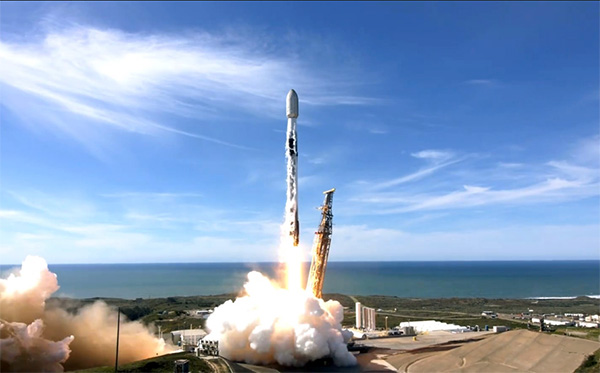
“ROCKET LAUNCH ALERT!”
You may or may not be familiar with The Militant’s regular advisory posts informing y’allz peeps about rockets launching from Vandenberg [Insert Armed Forces Branch Here] Force Base. At only 150 miles to our west-northwest, it’s virtually in our ‘hood, and (most) rocket launches are regularly visible (well…most of the time) from the Los Angeles area.
But have you seen them in person?
The Militant was able to witness a Vandenberg SpaceX launch up-close and personal (well, from three miles away) back in early May 2024, and it’s a pretty awesome experience that can not only be seen, but heard and felt. This post is a guide to help you get the opportunity to see one for yourself!
PLANET OF THE BASE
You’ve heard of Vandenberg, but where and what is it, exactly? Established in 1941 by the U.S. Army as Camp Cooke (named after Civil War hero and Union General Philip St. George Cooke), it was originally intended as a training ground for infantry, and an 86,000-acre expanse of coastal dune, scrub and chaparral land just a few miles west of the town of Lompoc along California’s Central Coast was selected for its varied terrain. That all came in handy within a year as it trained troops for World War II, and also served as a detention camp for captured German and Italian prisoners of war. In the ’50s, Camp Cooke continued to train troops, this time for the Korean War. In the mid ’50s, the Cold War and these new-fangled vertical weapons called missiles made Camp Cooke an attractive and strategic locale for launches, especially in a relatively-remote coastal area that doesn’t involve deployments directly over Los Angeles or San Francisco. and Its geographical spread along the coast between Point Sal and Point Arguello with a straight-line shot to the South Pole made it the perfect spot for polar orbit launches. In 1957, Camp Cooke was transferred to the U.S. Air Force and re-named Cooke Air Force Base. A year later, it was re-named Vandenberg Air Force Base in honor of USAF general Hoyt Vandenberg, who passed away in 1954.
Around that time, the Soviet Union launched the Sputnik satellite into orbit, and the Space Race was on. Vandenberg’s strategic and convenient location for launching missiles applied to satellites as well, and by the mid 1960s, the base expanded to its current size of 99,099 acres to accommodate space launch facilities. In the 1980s, NASA’s reusable space shuttle program took off, and while Florida’s Kennedy Space Center was ideal for launching shuttles and satellites into low-Earth and geosynchronous orbits, Vandenberg was being primed to be NASA’s polar orbit shuttle launch site counterpart…that was…until January 1986, when the tragic Challenger explosion put a screeching halt to Vandenberg’s shuttle launch plans. Through the ’90s and ’00s decades, Vandenberg was the site of Delta IV and Atlas V rockets propelling scientific, military and commercial satellites into orbit.
The 2010s heralded the SpaceX era, with the first version of the Hawthorne-based aerospace company’s Falcon 9 rocket making its maiden Vandenberg launch in September 2013. In October 2018, the reusable first stage of a Falcon 9 landed back at Vandenberg (known as an RTLS – Return To Launch Site – landing) for the first time.
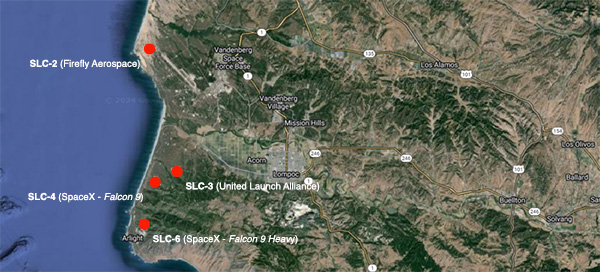
Since then, Vandenberg rocket launches have been a fairly regular occurrence, and though SpaceX now launches Falcon 9 rockets every 2-3 weeks, other companies, such as United Launch Alliance (Boeing/Lockheed Martin‘s joint aerospace venture), Northrop Grumman Space Systems and Firefly Aerospace lift off from the Central Coast a few times a year from its SLCs (Space Launch Centers) that Vandenberg leases to the respective aerospace companies. The facility was re-re-designated to a U.S. Space For- …oops…Space Force installation in May, 2021.
LIVE FROM LOMPOC
So you wanna see a rocket launch in person? Here’s a few things you need to keep in mind first (uh oh, The Militant is goin’ all listicle on ya now…):
1. Rocket Launches Are Always Tentative Things – It’s said that 5,000 things need to go right before a rocket launches, and if just one thing goes wrong, then the launch has to be scrubbed, or at least delayed. Normally, launches are given a three-hour launch window to allow for minor delays, and it the situation cannot be rectified within that window, the launch is scrubbed for that day and re-scheduled for another day, with a similar launch window. Most delays are either due to weather (stormy/heavily cloudy/high wind conditions can delay launches) or technical issues (i.e. the aforementioned list of 5,000 things that need to go right).
2. Check, Check, One Two – Check for upcoming launches here. Make sure to check the weather forecast for Lompoc, CA in advance. Being 150 miles away, it may or may not be the same as in Los Angeles, so a clear, sunny day here might not apply to Vandenberg.
3. Allow Some Time – Allow at least 2-3 hours drive time (we’ll get to alternate transportation modes later, hang tight…) from Los Angeles to Lompoc. On top of that, allow at least an hour and a half (90 minutes) before the scheduled launch time to arrive at the viewing site. If the launch is during the weekend, allow even more time due to crowds.
4. What To Bring – You’ll be hanging out at the viewing site for at least an hour or so. Folding chairs, food/snacks (leave no trace – clean up after yourselves, please…pack your trash as there are no trash cans out in the fields), binoculars if you want to see the rocket in detail. A tripod is not necessary as the rocket will be moving quickly and very vertically. Bring layers of clothing in case of chilly/windy weather. Sunscreen for broad daylight launches. Also make sure to take care of your potty business beforehand – there are no restroom facilities out there. Cell/data coverage can be spotty, due to being away from developed areas (unless you’re a Total Musk Fanboi and got a Starlink connection). The launches attract a diverse cross-section of people from across not only Southern California but the Southwestern U.S., and there’s a healthy mix of launch n00bz and launch veteranos (who can share their own viewing tips from experience) in the crowd.
5. Consider Local Accommodations – Investing in a two and a half-hour drive from Los Angeles and waiting two more hours at the viewing site is quite a time investment, and if the launch is scrubbed for that day, the entire trip can feel like a futile waste of time. But if you plan on staying local in Lompoc, Buellton, Solvang, Santa Ynez, Los Olivos or Santa Maria (all less than an hour’s drive of Vandenberg, with numerous motel/airbnb options) for a couple days, then a scrubbed launch might not feel like a lost cause, as you can make a short trip to see the next launch attempt.
6. Always Have A Plan B – In case you’re only here for the day and the launch is scrubbed, don’t fret. There’s still tons to do in the area to make the trip worth your while: Danish eats and treats in Solvang, exploring the murals of Lompoc, wine tasting in the Santa Ynez Valley – a.k.a California Wine Country South, playing your luck at the Chumash Casino, hanging out at the local beaches and state parks such as Gaviota, Springtime wildflower viewing along Figueroa Mountain Road in the Los Padres National Forest, camping or boating at Lake Cachuma, among other things. Check out The Militant’s post on his recent daylong road trip adventure in the Santa Ynez Valley – even if you do get to witness a launch successfully.
VIEWING SITES
Vandenberg rocket launches are easily seen (and heard) all over Santa Barbara County (and a little bit of San Luis Obispo and Ventura counties). There are actually numerous vantage points for witnessing blast-offs, but The Militant will focus on two of the closest and easily-accessible sites (for us civilians) – Surf Beach and the intersection of Ocean and Union Sugar avenues, just west of the city of Lompoc:

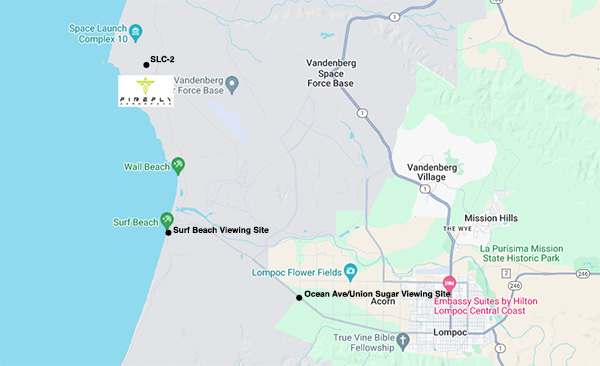
Surf Beach Viewing Site
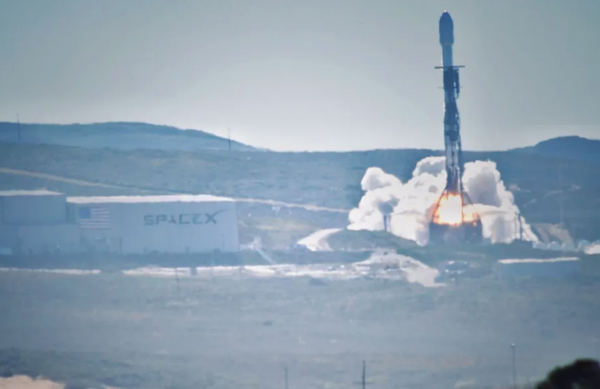
This is the prime location for viewing rocket launches from SLCs 4, 6 (SpaceX) and 3 (ULA) to the south and SLC-2 (Firefly Aerospace) to the north. This is as close as you can get to the launch site on land. Be warned – this location has limited parking (there is a small lot adjacent to the Amtrak Pacific Surfliner station) and parking on the road shoulder and will fill up fast – allow at least 2 hours prior to scheduled launch time to arrive here. The launch pads at SLC-3 (ULA) and SLC-4 (SpaceX) are easily visible to the south and you can even see the steam/smoke plume as the rocket lifts off. But do note – in the event of SpaceX RTLS 1st-stage landings, this location will be closed to the public due to safety and security protocols.
Directions from Los Angeles: Take the 101 North past Santa Barbara; 7 miles after the Gaviota tunnels (you can’t miss ’em), exit Route 246 (Lompoc/Solvang), turn left, head straight down the 246 past the traffic circle and downtown Lompoc, along Ocean Avenue until it ends at Surf Beach.
Ocean Avenue/Union Sugar Viewing Site
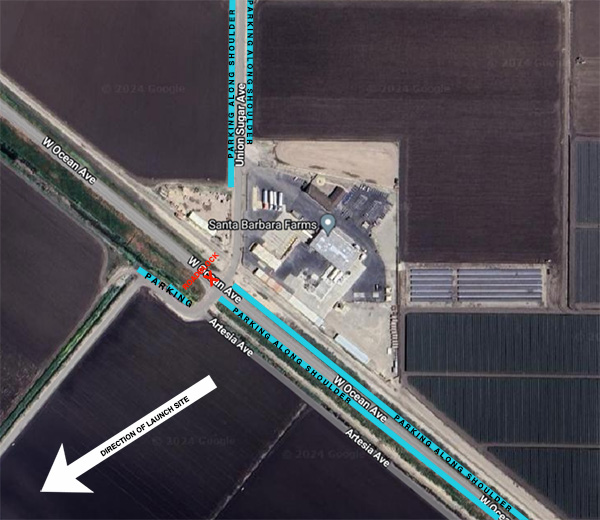
In the event of RTLS landings (normally 8-10 minutes after liftoff), this is the best seat in the house. In the event of a police/military roadblock on Ocean Avenue and Union Sugar Avenue (the area was home to the sugar beet growing and processing industry from the 1890s to the 1990s) blocking the way to Surf Beach, this is as far as you can get anyway. Illuminated advisory signs along Ocean Avenue will say, “NO PARKING ON SHOULDER” during launch days, but if you are close to the roadblock, this will not be enforced as everyone will be parking on the shoulder.
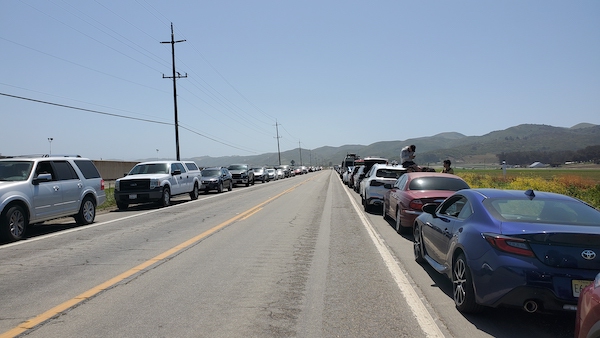
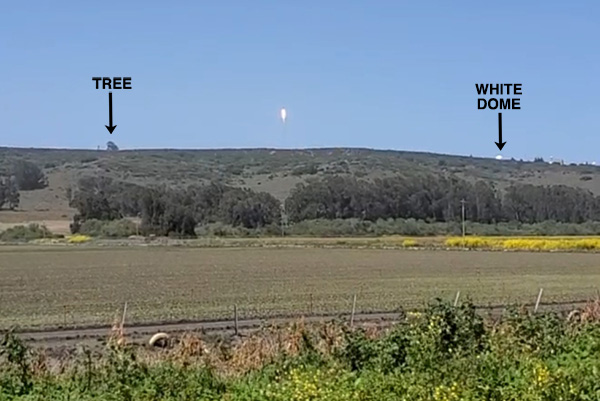
You will find yourself in a flat farmland plain with low hills to the north and south. Coastal breezes are common here. Once you’ve found a place to park (preferably on the south side of the road), look to the crest of the hill towards the southwest. You’ll see a white domed structure (part of Vandenberg) and a solitary tree to the left of it. Midway between those two points is where SpaceX’s SLC-4E launchpad is located. Set your eyes, tripods, cameras or binoculars to that spot, as that’s where the Falcon 9 rocket will emerge a few seconds after liftoff time. For ULA launches from SLC-3, the rocket will emerge closer to the white dome.
NOTE: For Firefly Aerospace launches from SLC-2, you need to look towards the northwest, as the launchpad is located on the northern half of Vandenberg. An alternate site for Firefly Aerospace launches is off of Highway 1 (Cabrillo Highway) north of Santa Lucia Canyon Road. Just look west towards the coast, and that’s where SLC-2 is located.
Directions from Los Angeles: Take the 101 North past Santa Barbara; 7 miles after the Gaviota tunnels (you can’t miss ’em), exit Route 246 (Lompoc/Solvang), turn left, head straight down the 246 past the traffic circle and downtown Lompoc, along Ocean Avenue to Union Sugar Avenue (there will be a military roadblock here, you can’t miss it).
OUT TO LAUNCH!

For SpaceX launches, the only way to keep current track of launch status is via SpaceX’s launch website. They will have an image menu of upcoming launches and dates (though SpaceX is known to have multiple launches from its Florida and Texas launch sites on the same date, so pay attention to the launch descriptions). There will be a live video feed of the launch starting less than 10 minutes prior to launch time (Which is also posted on SpaceX’s Twitter account – yeah, that shit’s still called Twitter, fight The Militant). Do be advised that cell coverage in the fields and on the beach is spotty to nonexistent, so when in doubt, consult with your fellow viewers on-site. Any changes to the launch time/date will be updated in the official mission profile page.
Assuming the rocket lifts off on schedule (or with minimal delay within the scheduled 3-hour launch window), though you’d naturally want to capture the moment on video/photo for social media or personal archival purposes, do make an effort to see the launch with your own eyes instead of looking directly at the screen. For SpaceX Falcon 9 launches, do gaze at the shape of the vehicle, namely trademark white bulge of the payload fairing atop the 229-foot rocket. This is a special moment, you’ve come 150 or so miles to witness this! Savor it! Listen to the rumble of the rocket and the violent ripping of the air as the rocket climbs in the sky! Don’t be afraid to cheer, whoop or holler, as others will be doing the same! This is an experience! You are here! This is live! Enjoy it!
If you’re familiar with watching Vandenberg launches from Los Angeles, they’re a long, vertical arc coming from the northwest, crossing due south. But witnessing the launch from such close proximity yields a much different perspective. For one, if you’re watching a launch in broad daylight, it’s right there in front of you, and the bright orange flame gleams nearly sun-bright, contrasting against the pale blue sky, whereas it’s most likely not visible from back in Los Angeles as the sunshine and bright blue sky will wash out the sight of the flame at that distance. And since you’re basically below the rocket, prepare to crane your neck as the view of the launch will be much, much, much more vertical in nature (The Militant, who normally frowns upon vertical video and photos will give his okay this time around).
As for evening launches, though the auditory experience will be the same, you may or may not be able to see the actual rocket, depending on how much remnant sunlight remains in the sky – although the flame will obviously be very visible (The Militant has not yet witnessed a twilight/nighttime Vandenberg launch in-person as of yet – though he would very much would like to return to Lompoc for the experience). The noctilucent vapor trail visible up to two hours after sunset will take on a shorter shape in the sky as you’re basically looking through it and not across it.
BUT WAIT…THERE’S MORE!
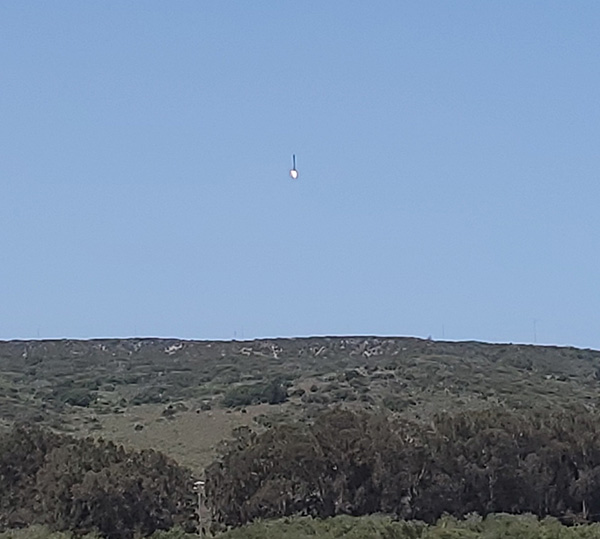
The distinguishing feature of SpaceX’s Falcon 9 rocket is its ability to re-use its first stage by having it land back to Earth vertically, with the aid of side thrusters keeping it in position. Most of the time, especially for Starlink launches, the first stage lands on an autonomous spaceport drone ship (ASDS), called Of Course I Still Love You off of the Baja California coast. But roughly 20 percent of Falcon 9 launches require a return to launch site (RTLS) landing on an area just adjacent to its SLC-4E launchpad roughly 8 to 10 minutes following liftoff. Not only is this a badass awesome exciting experience, but it makes the trek out to Lompoc even more worth it as you get to see not one, but two rocket events.
Usually, launch announcements will mention the landing (and The Militant will mention the RTLS landing in his “ROCKET LAUNCH ALERT” tweets). You can pretty much tell by the larger-than-normal crowd gathering at viewing sites and the fact that everyone still stays put after the launch.
At about 8 minutes after launch time, pay attention to the skies above the launch site. Those with binoculars or telephoto lenses would be able to see it, but to the naked eye, it won’t be visible for another minute or so. Then a quickly (really quickly now) descending rocket flame, with a fire-blackened, flat topped first stage will drop just a couple degrees north of where it took off from, and then quickly vanish behind the crest of the hill in the horizon. Wait a few seconds…then you’ll hear a double sonic boom thundering in the sky – with the second boom sustaining for nearly a minute as it fades in volume. If the launch was fascinating, the RTLS landing doubles the fascination. The sonic boom marks the resounding finale of the show – which literally ends with a bang. The sound of shutting car doors and internal combustion ignitions (unless the Musk fanbois arrive via Teslas – and you’re guaranteed to see at least one Cybertruck there, seriously…) fill the air and everyone makes their exit east towards Lompoc.
ADDITIONAL RESOURCES
For a list of additional viewing locales in the area, Lompoc’s visitor’s bureau made their own Vandenberg Launch Site guide.
SpaceLaunchSchedule.com also has their own Vandenberg Launch Viewing Guide.
If you want to take a public guided tour of Vandenberg (not scheduled during launch dates – Booo!), information is here.
CAR-FREE OPTIONS

Sin carro? Going car-free? Viewing Vandenberg launches is still (somewhat) possible sans auto. The easiest way there is via Amtrak‘s Pacific Surfliner train, which has two daily San Luis Obispo-bound trains departing Los Angeles Union Station at 7:13 a.m. and 3:13 p.m. (arriving at Lompoc Surf Beach station at 11:20 a.m. and 7:22 p.m., respectively – route delays pending, of course). Advantage – if the launch is scheduled close to noontime, then you can watch the launch from the station itself (or just a short walk on the other side of a small hill to get a better view), without even worrying about crowds and parking in the area. Disadvantage – you won’t be able to take a same-day return trip back to Los Angeles (Amtrak’s other train on these tracks, the Coast Starlight, does not make a stop here), so you need to make your own overnight accommodations in the Lompoc/Santa Ynez Valley area (you can bring a bike onboard the Surfliner train and ride into Lompoc from the Surf station – a distance of 9.8 miles over mostly flat farmland). Otherwise, get an Uber/Lyft ride (if you can get signal there).
Just note that the Lompoc/Surf station will be closed to the public in the event of a rocket launch that involves a RTLS 1st-stage landing. Also, make sure you arrive well in advance of a launch, as Amtrak Surfliner and Coast Starlight service will be temporarily halted within Vandenberg grounds during launch windows.
Alternately, if you can make your way to Santa Barbara, there’s the Clean Air Express commuter bus from Downtown Santa Barbara to the Lompoc Park & Ride lot at J Street and Cypress Avenue in downtown Lompoc (bicycles can be transported on the bus for your first/last mile needs). Lompoc also has its own bus transit agency, City of Lompoc Transit (COLT) – though it unfortunately does not venture west of V Street. Speaking of bikes, Lompoc also has a pretty extensive bike route network for a town of its size.
Yo, whatup! Did you enjoy this rocket launch guide? Are you inspired to take a trip up the 101 and through the 246 in the near future?
The Militant needs your help in funding the annual renewal of his website hosting package and militantangeleno.com domain! Support The Militant Angeleno’s covert operations today: https://www.paypal.com/donate/?hosted_button_id=K5XC5AM9G33K8

You must be logged in to post a comment.